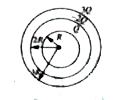A point charge –q revolves around a fixed charge +Q in elliptical orbit. The minimum ar.d maximum distance of q from Q are r1 and r2, respectively. The mass of revolving particle is Q>q and assume no gravitational effects. Find the velocity of q at positions when it is at r1 and r2 distance from Q.
The correct Answer is:A, B
To find the velocities of the point charge −q at the minimum distance r1 and maximum distance r2 from the fixed charge +Q, we can use the principles of conservation of angular momentum and conservation of mechanical energy.
1. Define Angular Momentum Conservation:
Since there are no external torques acting on the system, the angular momentum of the charge −q about the charge +Q is conserved.
\(
L = m v_1 r_1 = m v_2 r_2
\)
Here, \( v_1 \) is the velocity at distance \( r_1 \) and \( v_2 \) is the velocity at distance \( r_2 \).
2. Rearranging Angular Momentum Equation:
From the angular momentum equation, we can express \( v_1 \) in terms of \( v_2 \):
\(
v_1 = \frac{v_2 r_2}{r_1}
\)
3. Define Energy Conservation:
The total mechanical energy of the system is conserved. The mechanical energy at distance \( r_1 \) is equal to the mechanical energy at distance \( r_2 \):
\(
\frac{1}{2} m v_1^2 - \frac{k Q q}{r_1} = \frac{1}{2} m v_2^2 - \frac{k Q q}{r_2}
\)
4. Substituting for \( v_1 \):
Substitute \( v_1 \) from step 2 into the energy conservation equation:
\(
\frac{1}{2} m \left(\frac{v_2 r_2}{r_1}\right)^2 - \frac{k Q q}{r_1} = \frac{1}{2} m v_2^2 - \frac{k Q q}{r_2}
\)
5. Simplifying the Energy Equation:
Expanding the left-hand side:
\(
\frac{1}{2} m \frac{v_2^2 r_2^2}{r_1^2} - \frac{k Q q}{r_1} = \frac{1}{2} m v_2^2 - \frac{k Q q}{r_2}
\)
Rearranging gives:
\(
\frac{1}{2} m \frac{v_2^2 r_2^2}{r_1^2} - \frac{1}{2} m v_2^2 = -\frac{k Q q}{r_2} + \frac{k Q q}{r_1}
\)
6. Factoring Out \( v_2^2 \):
Factoring out \( v_2^2 \) from the left side:
\(
\frac{1}{2} m v_2^2 \left(\frac{r_2^2}{r_1^2} - 1\right) = \frac{k Q q}{r_1} - \frac{k Q q}{r_2}
\)
7. Solving for \( v_2^2 \):
Rearranging gives:
\(
v_2^2 = \frac{2 k Q q \left(\frac{1}{r_1} - \frac{1}{r_2}\right)}{m \left(\frac{r_2^2}{r_1^2} - 1\right)}
\)
8. Finding \( v_1 \):
Now substituting \( v_2 \) back to find \( v_1 \):
\(
v_1 = \frac{v_2 r_2}{r_1}
\)
Final Expressions:
- The velocity at minimum distance \( r_1 \):
\(
v_1 = \frac{r_2}{r_1} \sqrt{\frac{2 k Q q \left(\frac{1}{r_1} - \frac{1}{r_2}\right)}{m \left(\frac{r_2^2}{r_1^2} - 1\right)}}
\)
- The velocity at maximum distance \( r_2 \):
\(
v_2 = \sqrt{\frac{2 k Q q \left(\frac{1}{r_1} - \frac{1}{r_2}\right)}{m \left(\frac{r_2^2}{r_1^2} - 1\right)}}
\)
Since there are no external torques acting on the system, the angular momentum of the charge −q about the charge +Q is conserved.
\(
L = m v_1 r_1 = m v_2 r_2
\)
Here, \( v_1 \) is the velocity at distance \( r_1 \) and \( v_2 \) is the velocity at distance \( r_2 \).
From the angular momentum equation, we can express \( v_1 \) in terms of \( v_2 \):
\(
v_1 = \frac{v_2 r_2}{r_1}
\)
The total mechanical energy of the system is conserved. The mechanical energy at distance \( r_1 \) is equal to the mechanical energy at distance \( r_2 \):
\(
\frac{1}{2} m v_1^2 - \frac{k Q q}{r_1} = \frac{1}{2} m v_2^2 - \frac{k Q q}{r_2}
\)
Substitute \( v_1 \) from step 2 into the energy conservation equation:
\(
\frac{1}{2} m \left(\frac{v_2 r_2}{r_1}\right)^2 - \frac{k Q q}{r_1} = \frac{1}{2} m v_2^2 - \frac{k Q q}{r_2}
\)
Expanding the left-hand side:
\(
\frac{1}{2} m \frac{v_2^2 r_2^2}{r_1^2} - \frac{k Q q}{r_1} = \frac{1}{2} m v_2^2 - \frac{k Q q}{r_2}
\)
Rearranging gives:
\(
\frac{1}{2} m \frac{v_2^2 r_2^2}{r_1^2} - \frac{1}{2} m v_2^2 = -\frac{k Q q}{r_2} + \frac{k Q q}{r_1}
\)
Factoring out \( v_2^2 \) from the left side:
\(
\frac{1}{2} m v_2^2 \left(\frac{r_2^2}{r_1^2} - 1\right) = \frac{k Q q}{r_1} - \frac{k Q q}{r_2}
\)
Rearranging gives:
\(
v_2^2 = \frac{2 k Q q \left(\frac{1}{r_1} - \frac{1}{r_2}\right)}{m \left(\frac{r_2^2}{r_1^2} - 1\right)}
\)
Now substituting \( v_2 \) back to find \( v_1 \):
\(
v_1 = \frac{v_2 r_2}{r_1}
\)
- The velocity at minimum distance \( r_1 \):
\(
v_1 = \frac{r_2}{r_1} \sqrt{\frac{2 k Q q \left(\frac{1}{r_1} - \frac{1}{r_2}\right)}{m \left(\frac{r_2^2}{r_1^2} - 1\right)}}
\)
\(
v_2 = \sqrt{\frac{2 k Q q \left(\frac{1}{r_1} - \frac{1}{r_2}\right)}{m \left(\frac{r_2^2}{r_1^2} - 1\right)}}
\)
Topper's Solved these Questions
- BOOK - DC PANDEY ENGLISHCHAPTER - ELECTROSTATICSEXERCISE - Exercise 24.14videos
ELECTROSTATICS
- BOOK - DC PANDEY ENGLISHCHAPTER - ELECTROSTATICSEXERCISE - Exercise 24.29videos
ELECTROSTATICS
- BOOK - DC PANDEY ENGLISHCHAPTER - ELECTROSTATICSEXERCISE - Example Type 83videos
ELECTROSTATICS
- BOOK - DC PANDEY ENGLISHCHAPTER - ELECTROSTATIC POTENTIAL AND CAPACITORSEXERCISE - (C) Chapter exercises50videos
ELECTROSTATIC POTENTIAL AND CAPACITORS
- BOOK - DC PANDEY ENGLISHCHAPTER - GRAVITATIONEXERCISE - All Questions135videos
GRAVITATION
Similar Questions
Find the value of :
2p + 3q + 4r + por when p =-1,q = 2 and r = 3View SolutionCharge q2 of mass m revolves around a stationary charge q1 in a circulare orbit of radius r. The orbital periodic time of q2 would be
View SolutionA particle of mass m carrying charge '+q1' is revolving around a fixed charge '−q2' in a circular path of radius r. Calculate the period of revolution.
View SolutionTwo particles p and q located at distances rp and rq respectively from the centre of a rotating disc such that rp>rq.
View SolutionFind out potential energy of the two point charge system having charges q1 and q2 separated by distance r.
View SolutionA particle of mass m carrying a charge −q1 starts moving around a fixed charge +q2 along a circulare path of radius r. Find the time period of revolution T of charge −q1.
View SolutionTwo concentric conducting shells of radii R and 2R are having charges Q and -2Q respectively.In a region r
View SolutionThree concentric conducting spherical shells of radii R,2R carry charges Q, -2Q and 3Q, respectively. Find the electric potential at r = R and at r = 3 R, where r is the radii distance from the centre.
 View Solution
View SolutionThe electrostatic potential of a uniformly charged thin spherical shell of charge Q and radius R at a distance r from the centre
View SolutionA positive charge +Q is fixed at a point A. Another positively charged particle of mass m and charge +q is projected from a point B with velocity u as shown in (Fig. 3.103). Point B is at a large distance from A and at distance d from the line A C. The initial velocity is parallel to the line A C. The point C is at a very large distance from A. Find the minimum distance (in meter) of +q from +Q during the motion. Take Qq=4πε0mu2d and d(√2−1)m.
 .View Solution
.View Solution

